Ohio is home to 24 salamander species, with the most common species being the spotted salamander and the red-backed salamander among others.
These salamanders are silent, and spend most of the year hibernating, or hiding under rocks, logs, and other debris, so people rarely see them.
You are most likely to encounter one of these salamanders on a rainy day in spring when they emerge from hibernation and migrate to breeding ponds.
Native Salamanders of Ohio
As earlier mentioned, Ohio is home to 24 salamander species, some species more common than others. Since there are so many different salamander species, the exact size and coloration vary between species.
Also, some species are semi-aquatic, some fully aquatic, and some fully terrestrial! If you ever spot a salamander in Ohio, It’s probably one of these. You can potentially see salamanders of any age or gender!
1. Red-Backed Salamander


| Scientific Name | Plethodon cinereus |
| Average Adult Size (Length) | 2 – 5 inches |
| Average Lifespan (Years) | 15 – 20 |
Red-backed salamanders have slender bodies and reach between 2 and 5 inches. Despite their name, not all “red-backed ” salamanders have the color red on their backs.
They have many color variations but mainly have two variations: The red-back, and the lead- morph.
The red-back morph has a straight-edged reddish stripe (sometimes orange, yellow, or dark grey) running the length of its back from the base of the head to the tail, with dark sides. The lead-back morph, on the other hand, lacks the red stripe. It has a purely dark grey to black color on its back instead. There also exists a morph where the whole body of the salamander is a pinkish red, sometimes with black spots.
Red-backed salamanders are one of Ohio’s most abundant salamander species, distributed across most of the state.
2. Spotted Salamander


| Scientific Name | Ambystoma maculatum |
| Average Adult Size (Length) | 6 – 9 inches |
| Average Lifespan (Years) | 15 – 20 |
Spotted salamanders (sometimes called “yellow-spotted salamanders“) are fairly large, ranging from 6 to 9 inches long, with females typically larger than males.
They get their name from the two roles of yellow or orange spots speckled along their black backs and sides. Their underside is pale gray with no spots.
Spotted salamanders have broad heads and thick, heavy bodies with vertical grooves on each side of their body.
These salamanders are found all over the state of Ohio but are less common in the north-eastern and north-western parts of the state.
3. Blue-Spotted Salamander

| Scientific Name | Ambystoma laterale |
| Average Adult Size (Length) | 3 – 5 inches |
| Average Lifespan (Years) | 10 – 15 |
Blue-spotted salamanders are relatively slender salamanders ranging from 3 to 5 inches in length. They have a long fleshy tail (accounting for about 40% of the total body length) that is broadly oval at the base and compressed towards the tip.
These salamanders have a gray to blue-black coloration with blue spots on their sides, tails, and legs (hence their name).
Blue-spotted Salamanders are one of the rarest salamander species in Ohio and are currently listed as engendered in the state. They are only found in the northwest corner of the state.
4. Smallmouth Salamander

| Scientific Name | Ambystoma texanum |
| Average Adult Size (Length) | 4.3 – 7 inches |
| Average Lifespan (Years) | 15 – 20 |
Smallmouth salamanders are sometimes called “Texas salamanders” or “narrow-mouthed salamanders”. They range between 4.3 and 7 inches in length and can be best identified by their small head with a blunt, short snout. The head tends to appear swollen behind the eyes.
These salamanders have a brownish-gray to grayish-black coloration with light gray speckles of lichen-like blotches, particularly along the lower sides of the body. The underside is of the same color with little or no speckling.
Smallmouth salamanders are found across the entire state of Ohio but are more common in the northern half of the state.
5. Marbled Salamander


| Scientific Name | Ambystoma opacum |
| Average Adult Size (Length) | 3 – 5 inches |
| Average Lifespan (Years) | 8 – 10 |
Marbled salamanders are fairly small, only growing 3 to 5 inches in length. They have a dark grey to black coloration with silvery crossbands running along with their chunky bodies. Because of this appearance, they are sometimes called “banded salamanders“.
Male marbled salamanders are typically smaller than females and have whitish crossbands that become very white in the breeding season.
In Ohio, marbled Salamanders are distributed along some of the lakeshore counties, but are most common in southern Ohio.
6. Eastern Tiger Salamander

| Scientific Name | Ambystoma tigrinum |
| Average Adult Size (Length) | 6 – 9 inches |
| Average Lifespan (Years) | 15 – 25 |
Tiger salamanders typically range from 6 to 9 inches but can grow up to 13 inches, which makes them the largest terrestrial salamanders in Ohio, and one of the largest terrestrial salamanders in North America.
These salamanders can be easily identified by their dull brown coloration, with olive-yellow to brownish-yellow irregular markings (“tiger stripes”). The markings can be large spots, stripes, or irregularly shaped spots.
Eastern tiger salamanders are patchily distributed across the state of Ohio, but they are rarely encountered.
7. Jefferson Salamander

| Scientific Name | Ambystoma jeffersonianum |
| Average Adult Size (Length) | 4 – 7 inches |
| Average Lifespan (Years) | 10 – 15 |
Jefferson salamanders can be easily identified by their grey or dark brown-colored back with blueish-white speckling on the lower sides. The speckling is most visible in younger salamanders and may disappear in older adults.
These salamanders are medium-sized, ranging from 4 to 7 inches in length with females being larger than males.
Jefferson salamanders have a long tail, (almost as long as the body) which is vertically compressed but nearly rounded at the base.
In Ohio, Jefferson Salamanders are found across most of the state but are most common in southern Ohio north through a narrow band of counties stretching to northeastern Ohio.
8. Northern Dusky Salamander


| Scientific Name | Desmognathus fuscu |
| Average Adult Size (Length) | 2 – 5 inches |
| Average Lifespan (Years) | 10 – 15 |
Northern dusky salamanders are fairly small, only growing between 2 to 5 inches in length.
Their coloration is highly variable, but they are generally tan to dark brown with sparse dark spots that are concentrated on the sides, and may also have a light dorsal stripe or two dark dorsal stripes.
Younger individuals may have paired round yellowish spots bordered by a dark wavy band. In older individuals, the spots are gone and the wavy band may be indistinguishable from the body color.
As in all dusky salamander species, a pale line runs diagonally from the eye to the jaw, and the hind legs are larger than the front legs.
Northern dusky salamanders are distributed across most of the state of Ohio but are most common in the eastern and southern parts of the state.
9. Mountain Dusky Salamander

| Scientific Name | Desmognathus ochrophaeus |
| Average Adult Size (Length) | 2 – 5 inches |
| Average lifespan (years) | 10 – 15 |
This is a subspecies of dusky salamander, so it is very closely related to the Northern Dusky.
Mountain Dusky Salamanders are extremely similar to their relatives. They are the same size and share the same features. Their main physical difference is their coloration.
- The Mountain Dusky is typically more brightly colored with a dorsal stripe that is yellow to red with chevron-shaped dark patches alongside the stripe and a dark underside.
- The Northern Dusky, on the other hand, has a tan or brown stripe with no markings and a pale cream-colored underside.
In Ohio, Mountain Duskies are only found in eight counties in the extreme northeastern part of the state.
10. Spring Salamander
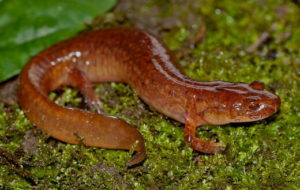

| Scientific Name | Gyrinophilus porphyriticus |
| Average Adult Size (Length) | 4 – 8 inches |
| Average Lifespan (Years) | 10 – 15 |
Spring salamanders are about 4 to 8 inches in length and have an orangish-pink body; covered in faint small black spots or flecks. Sometimes, their coloration can be yellowish-brown with a mottled appearance.
These salamanders have slender bodies, a light line extending from the eyes to the nostril, and a ridge along their tail to help them swim better.
Spring salamanders around the Appalachian Mountains and north into the Adirondacks and just into Canada. In Ohio, they are distributed across most of the state but are rarely encountered.
11. Streamside Salamander

| Scientific Name: | Ambystoma barbouri |
| Average Adult Size (Length) | 5 – 7 inches |
| Average lifespan (years) | Unknown, but estimated to be 10 – 15 |
Streamside salamanders are relatively large salamanders (5 to 7 inches in length) with a stocky body and a small head. They have a gray to dark brown coloration with lighter gray lichen-like patterns on the sides of the body.
These salamanders look nearly identical to smallmouth salamanders and can be difficult to tell apart. The main way to differentiate them is by location and habitat.
- Streamside salamanders are found in streams with limestone bedrock
- Smallmouth salamanders are found in pools and ditches
In Ohio, streamside salamanders are only found in the Southwestern part of the state.
12. Northern Red Salamander


| Scientific Name | Pseudotriton ruber |
| Average Adult Size (Length) | 6 – 7 inches |
| Average Lifespan (Years) | 15 – 20 |
Northern red salamanders are 6 to 7 inches in length and have a bright orangish-red coloration with random black spots on the back and sides. Older red salamanders are typically darker and may have fused spots making them look purplish brown.
These salamanders have a short tail and have 16 grooves along their body. Like many salamanders, females are larger than males.
Red salamanders are found in the eastern United States, from Alabama to northern New York. In Ohio, they are limited to the eastern half of the state.
13. Midland Mud Salamander

| Scientific Name | Pseudotriton montanus diastictus |
| Average Adult Size (Length) | 4 – 6 inches |
| Average Lifespan (Years) | 15 – 20 |
Mud salamanders grow between 3 and 6 inches in length. They have a reddish-brown coloration with well-black spots which makes them look very similar to red salamanders.
However, there are several ways you can tell these two salamanders apart.
- The red salamander has spots that are irregularly shaped and frequently overlap. In contrast, the mud salamander has fewer spots that are well separated from one another and do not overlap.
- The red salamander has a golden/Yellow iris. In contrast, the Iris of the mud salamander is solid black/brown color.
- The red salamander has long snout. In contrast, the snout of the mud salamander is shorter and blunter.
In Ohio, mud salamanders have only been reported in 8 southeastern counties.
14. Ravine Salamander

| Scientific Name | Plethodon richmondi |
| Average Adult Size (Length) | 3 – 5 inches |
| Average Lifespan (Years) | Unknown, but estimated to be 15-20 |
The ravine salamander is a thin, elongated salamander with short legs and a long tail that makes up half of its total body length. It is fairly easy to identify because it is Ohio’s most slender salamander species.
This Salamander is dark brown to black above with silver-white or brassy flecking. The underside is uniformly dark except for the chin which is a paler gray with light flecking.
Ravine salamanders are distributed across much of the state of Ohio but are most common in the Southern and eastern parts of the state.
15. Long-Tailed Salamander
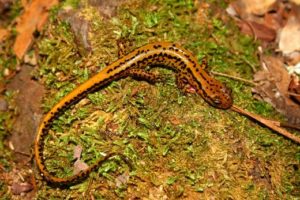
| Scientific Name | Eurycea longicauda |
| Average Adult Size (Length) | 4 – 8 inches |
| Average Lifespan (Years) | 5 – 10 |
Long-tailed salamanders are often yellow but can range in color to red, orange, and brown and have irregular dots and dashes along their slender bodies and tails.
As their name suggests, they have really long tails. They grow 4 to 8 inches, with 60% of this length being their tails.
Long-tailed salamanders in Ohio are most common in the Southwestern and eastern parts of the state.
16. Green Salamander
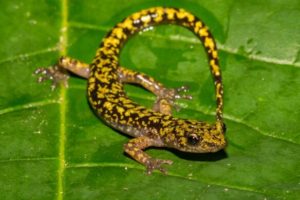
| Scientific Name | Aneides aeneus |
| Average Adult Size (Length) | 3 – 6 inches |
| Average Lifespan (Years) | 10 – 15 |
Green salamanders are quite easy to identify because they are the only salamander in Ohio with green-colored blotches on the back. If you ever see a salamander will green blotches in Ohio, you can be 100% sure it’s a green salamander.
These salamanders grow 3 to 6 inches in length. The body and head are flattened with numerous green to yellowish-green markings that resemble lichens.
Green salamanders are one of the rarest of Ohio’s salamanders are only known from a handful of rocky outcrops along the Ohio River. They are currently listed as state endangered.
17. Northern Two-lined Salamander
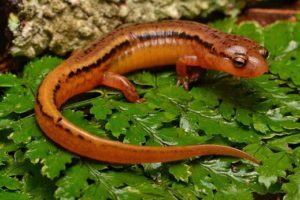

| Scientific Name | Eurycea bislineata |
| Average Adult Size (Length) | 2 – 4 inches |
| Average Lifespan (Years) | Unknown, but estimated to be 5 – 10 |
Northern two-lined salamanders are on the small side, only growing between 2 to 4 inches in length. You easily identify them by their greenish-yellow or orange back with two parallel dark brown or black lines running from their eyes to their tail.
Male two-lined salamanders have small projections from the nostrils that point downwards. These projections are thought to help them in chemoreception.
In Ohio, Northern two-lined salamanders are limited to the north of a line extending from central Knox County to central Jefferson County.
18. Southern Two-lined Salamander

| Scientific Name | Eurycea cirrigera |
| Average Adult Size (Length) | 2 – 4 inches |
| Average Lifespan (Years) | Unknown, but estimated to be 5 – 10 |
As their name suggests, southern two-lined salamanders are extremely closely related to Northern two-lined salamanders. In fact, these two salamanders are nearly identical.
Their main distinction is that; while the northern two-lined salamander has 15-16 costal grooves between its limbs, the southern two-lined salamander only has 14 costal grooves.
Besides this tiny difference, they can be difficult to tell apart.
In Ohio, Southern Two-lined Salamanders are found South of the range of Northern two-lined salamanders.
19. Four-toed Salamander


| Scientific Name | Hemidactylium scutatum |
| Average Adult Size (Length) | 2 – 4 inches |
| Average Lifespan (Years) | Unknown, but estimated to be 8 – 12 |
Four-toed salamanders range from 2 to 4 inches in length. They get their name from the four toes on both their front and hind feet. No other salamander species has 4 toes on each foot (most salamanders have five toes on the back feet, and four on the front feet).
Four-toed salamanders have a reddish-brown or grey-brown coloration on the back, with grey sides and a white belly with black spots.
These salamanders also have an obvious constriction at the base of the tail where it can detach if grabbed by a predator, allowing the salamander to escape.
Four-toed salamanders are widely scattered across much of Ohio but are rarely encountered.
20. Northern Slimy Salamander

| Scientific Name | Plethodon glutinosus |
| Average Adult Size (Length) | 4 – 6 inches |
| Average Lifespan (Years) | 15 – 20 |
Northern slimy salamanders are medium-sized, growing between 4 and 6 inches in length.
They are easy to identify by their bluish-black bodies with numerous, well-scattered white spots on the back and sides. The spots along the sides of their bodies may fuse and form a broad band.
Slimy salamanders get their name from the very sticky mildly toxic goo they secrete when threatened. This goo sticks to the predator’s mouth enabling the salamander to escape.
Northern slimy salamanders are distributed across most of Ohio but are most common in the eastern and southern portions of the state. 
| Scientific Name | Eurycea lucifuga |
| Average Adult Size (Length) | 5 – 8 inches |
| Average Lifespan (Years) | 15 – 20 |
Cave salamanders, sometimes called spotted-tail salamanders, are relatively large, ranging 5 to 8 inches in length. They have a slender body and long tail that accounts for 60-65% of their total length.
They have a bright reddish-orange to a bland yellow coloration and irregular black spots scattered around their body and tail.
This appearance makes them look very similar to the long-tailed salamander; the easiest way to differentiate them is by their spotting pattern.
- Long-tailed salamanders have spots that form bars on the tail
- Cave salamanders have spots that do not form bars on the base of the tail (hence the name “spotted-tail salamanders “)
Cave salamanders are uncommon in Ohio and have only been reported in the southwestern counties of Hamilton and Butler, and in Adams County in southcentral Ohio. They are currently listed as state endangered.
22. Eastern Red-Spotted Newt


| Scientific Name | Notophthalmus viridescens |
| Average Adult Size (Length) | 2 – 5 inches |
| Average Lifespan (Years) | 12 – 15 |
Eastern red-spotted newts sometimes called “eastern newts”, or simply “red-spotted newts” are the only kind of newt found in Ohio and grow between 2 and 5 inches in length. Unlike most salamanders, many newts (including the eastern newt) have rough skin that is slightly moist, (just enough to keep it from drying out).
In the Juvenile eft stage (which lasts about 3 to 4 years), eastern newts have a bright orange-red coloration with a rounded tail. 
As adults, they generally have a yellowish-brown to greenish-brown coloration, with black-bordered red spots along their back. The underside is yellow with small dark spots.
Males develop enlarged hind legs and a high wavey crest on their tails during the breeding season.
Eastern newts are distributed across most of the state of Ohio but are most common in the southern and eastern portions of the state.
23. Mudpuppy


| Scientific Name | Necturus Maculosus |
| Average Adult Size (Length) | 7 – 16 inches |
| Average Lifespan (Years) | 15 – 30 |
Mudpuppies reach 7 to 16 inches and are one of the few salamanders that are vocal. They get their name from their squeaky scream which sounds somewhat like a dog’s bark.
They are fully aquatic for their whole lives and retain their larval features even as adults. They have large feathery gills, four feet, and a flat fin that runs down the length of their body.
Their coloration is usually brownish-black with bluish-black spots or blotches. However, younger mudpuppies are often black with yellow stripes running along the length of their bodies.
Mudpuppies have been reported across much of the state of Ohio, but are uncommon and are currently listed as state endangered.
24. Eastern Hellbender
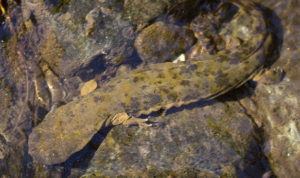

| Scientific Name | Cryptobranchus alleganiensis |
| Average Adult Size (Length) | 11 – 20 inches, can reach 29 inches |
| Average Lifespan (Years) | 30 – 50 |
Like the mudpuppy, hellbenders are fully aquatic. However, unlike the mudpuppies, hellbenders do not have gills. Rather, they breathe underwater through their skin.
Their skin has lots of folds and wrinkles which provides a large surface area to absorb oxygen in the water. Hellbenders can grow up to 29 inches in length, making them the largest salamanders in North America.
They can be easily identified by their wide flat heads, paddle-shaped tail, and their brown coloration with irregularly shaped dark spots along their back.
In Ohio, hellbenders are found mainly in the southeastern portion of the state and have been reported in the Ohio River drainage. Like the mudpuppy, they are currently listed as state endangered.
Final Thoughts
Ohio has 2 dozen salamander species, with some being more common their others.
Most of the salamanders in Ohio are terrestrial, but there are also 2 aquatic salamander species.
These interesting amphibians are all over Ohio, and you’re sure to catch sight of one if you take the time to look, especially in the spring when they are most active.



